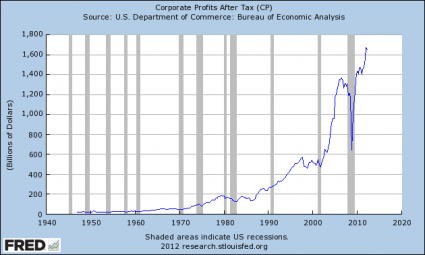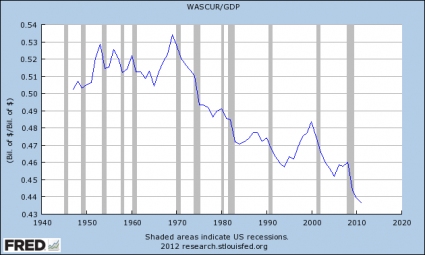Courtesy of 4.8 percent, Sabrient Systems and Gradient Analytics
[For charts and full newsletter read: Lies, Damn Lies and the Disappearing Middle Class]
Excerpt from MarketShadows September 9 2012
Is our nation being torn apart by inequality, lack of opportunity and a disappearing middle class? The short answer is that inequality is becoming more extreme and opportunity is declining. And while the middle class is not “disappearing,” a portion of its wealth and resources are.
Ron Haskins recently examined the rumors of the middle class’s demise. He noted that the contribution of government benefits to the poor is often ignored by people comparing income across different brackets:
“Our federal income tax system sends billions of dollars to poor and low-income households, substantially increasing their income and taking a bite out of inequality. Households in the top 1 percent pay about 40 percent of federal income taxes, and the top 10 percent pays nearly 75 percent.
“Put another way, the federal income tax system directly transfers billions in cash from the top to the bottom. Programs for poor and low-income families, including food stamps, the earned-income tax credit, Head Start and Pell Grants, annually transfer more than $900 billion in cash and other benefits to the poor and near-poor.” (The myth of the disappearing middle class)
Oddly, Ron uses massive government entitlement spending to suggest that the economy is not quite as impaired as alleged. Taking the opposite view, the need for huge transfer payments could be a symptom of underlying rot.
Jared Bernstein called ‘the myth of the disappearing middle class’ a canard. “Most living standards analysts, including Ron in this piece (!), think of the middle class as some chunk in the middle of the income distribution — say the middle fifth or some variation there in (e.g., 40th to 80th percentile) — which of course cannot by definition ‘disappear.’…”
“[Ron] cites research much like that of the Congressional Budget Office on family income trends, noting that middle class income (the middle fifth of the income scale) ‘grew by nearly 40 percent’ 1979-2007. (CBO analysis shows 35%… these trends include the effect of taxes, transfer payments, and the value of employer provided health care.).
“First of all, 35% over 28 years is 1.1% per year, over a period when productivity grew at twice that rate (up 72%, or 2% per year). There’s no reason to expect middle class incomes to grow at the rate of productivity year in and year out, though they did so for a few decades in the post-war years. But this persistent divergence is important context that should not be left out…
“To understand the middle class squeeze, you’ve got to look at wages and hours. Census data reveal the amazing fact that the median earnings of full-time male workers were almost exactly the same in real terms in 1979 as in 2010: in real 2010 dollars, 1979: $47,621; 2010: $47,715. How could that possibly not be relevant in an article about middle class well-being?” (The Myth of the Myth of the Disappearing Middle Class)
There will always be people earning wages and living somewhere in between poverty and riches. But there has been no growth in median earnings of full-time male workers since 1979. And without including tax effects, transfer payments, and the value of employer-provided health care, growth in “income” goes negative since the Great Recession.
In fact, real median household income fell almost 5 percent since the last recession: “The rich are getting richer, and the poor really are getting poorer… Americans are earning less today on average than they were when the Great Recession…ended… Using Census Bureau data, economists Gordon Green and John Coder determined that real median household income has actually fallen by 4.8% since the recession’s end. Even more surprisingly, they found that the decline since June 2009 was larger than the 2.6 percent decline that occurred during the recession. Adding them together, Green and Coder conclude that average household income has fallen 7.2% since December 2007.” (Average U.S. Household Has Lost 5% in Annual Income Since Economic “Recovery” Began)
Note: “income” and “earnings” are often not clearly defined. Ron Haskins included transfer payments, tax credits and employer-provided health care benefits in his income calculations. Gordon Green and John Coder arrived at a different result – negative growth – looking at earnings without the government treats. When looking at numbers, it’s important, but often difficult, not to compare apples to oranges…
A decrease in real wages resulted from jobs shifting from the middle and high wage ranges to lower paying jobs. Michael Snyder explored this in Economic Failure: 58 Percent Of The Jobs Being Created Are Low Paying Jobs:
“…58 percent of the jobs that have been created since the end of the recession have been low paying jobs. So exactly what is a low paying job? Well, the National Employment Law Project defines it as a job with an hourly wage between $7.69 and $13.83. But of course you can’t pay a mortgage or support a family on $13.83 an hour…
“Most of these new jobs are not paying enough to support a middle class lifestyle. This represents an economic failure on a fundamental level. Our economy is producing very few good jobs that enable people to be able to raise families and live the American Dream. The ranks of ‘the working poor’ are exploding and the number of Americans that are dependent on the government is sitting at an all-time record…”
A fundamental cultural shift in our economy has led to companies devaluing their workers and outsourcing millions of jobs. Michael attributes the changes to an emerging one world economy. “The big corporations no longer need American workers to make stuff. They can just close up shop and move their facilities to the other side of the globe where it is legal to pay slave labor wages to very desperate workers.”
For corporations, after-tax profits are soaring. Their success has come at the expense of labor. Wages (as a percentage of the economy) are at all-time lows.
.
.
.
Michael concluded that the middle class will continue declining, while families become poorer, as our employment economy transitions to an ownership economy. (Economic Failure: 58 Percent Of The Jobs Being Created Are Low Paying Jobs)
While income has declined, the cost of living continues to rise (regardless of spurious government claims to the contrary). As jobs available in the lower wage ranges increase, numbers of the “working poor” will also increase, and the “middle” will be forced down to lower levels.
In The Problem with “Tax The Rich”: It Won’t Work, Charles Hugh Smith examined the unfairness in our nation’s tax structure – it’s another hit to middle and higher income earners who pay for the transfer payments to the lower/zero wage earners.
“By heavily taxing earned income, the system extracts the highest taxes from the most productive citizens, leaving the less-productive with essentially no income taxes and the super-wealthy with the huge tax break offered to capital gains and other unearned income…
“As I noted in Tyranny of the Majority, Corporate Welfare and Complicity (April 9, 2010): ‘In essence, this is a vote-buying scheme by the Status Quo: the top 1% control the policies of the State in alliance with the State’s own Elites, and together they buy the complicity of the bottom 60% to passively accept their dominance.’
“In other words, the bottom 60% are recipients of Central State largesse and the top 1% who ‘own’ the political and thus the taxation process limit their taxes by favoring unearned income (what they collect from sales of securities, stock options, rents, etc.). Thus the productive quintile (top wage earners) pay the highest tax rates and most of the taxes.
“It’s a partnership of “Tyranny of the Majority” and “Outsized Influence of Elites.” If the political status quo alienates the majority by making them pay more taxes, they risk losing power in the next election. If they alienate the top 1% who fund their multi-million-dollar campaigns, then they will also lose power. So they heap the tax burden on those ‘rich’ who are actually earning their money rather than clipping coupons.”
In conclusion, the middle class is not “disappearing.” It’s becoming weaker, poorer and struggling to maintain its identity. Government action that has helped lower income groups (transfer payments), and rewarded the wealthiest (tax structure, tax breaks), is sucking life energy from the productive middle and upper middle classes.
Our analysis of the economy should not be confused with our analysis of the stock market. There’s a disconnect. As Bruce Krasting wrote,
“I spoke with a guy who runs a fund (with a couple of bucks of mine) this weekend. He was happy as can be. His fund’s performance has past the upside mark, so he’s getting a free 20% of any additional gains. Like all equity guys, he’s bullish for the rest of the year. His thinking is that common stocks of companies with good balance sheets, positive cash flow, and buying back stock have much more upside to them. Google at 800+ is in the cards, according to him.
“He made one interesting observation. He believes that equity prices have decoupled from the business cycle. Stocks can do well when the broad economy is struggling and government financing is in ruin.
“That sounds crazy to me. But it is exactly the status quo today. Stocks are at four year highs, while government financing (globally) is in the toilet, and about to be flushed. His justification for the optimistic outlook for equities was: ‘Who in their right mind would buy any government bonds today?’
“We shall see if the decoupling of stocks and the broad economy/public sector financing continues, but you can’t ague with what the guy says. Bernanke and the other central banks have converted the debt market into a very unlovable asset class. There is no return on the bonds; there is credit and yield risk. Bonds are a total downside story at this point.” (On Sub-Zero and Decoupling)
[…]
Also in MarketShadows September 9 2012:
TA by Springheel Jack, trend following by Allan Harris, an idea for going long gold using GLD. For a look into our virtual portfolio, click here.





